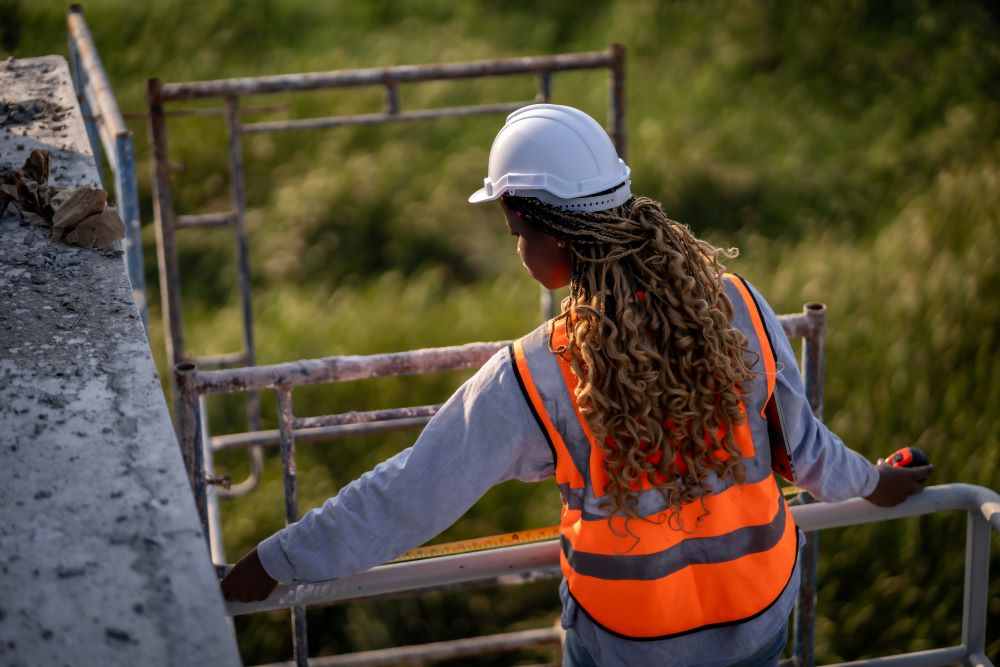If you employ individuals who work separately from others and without close supervision, it’s critical to understand lone worker safety.
This guide clarifies who qualifies as a lone worker, explores the risks they encounter, and outlines your duties as an employer to protect them.
What is a Lone Worker?

The Health and Safety Executive (HSE) defines lone workers as those who work by themselves without close or direct supervision.
This includes not only those who physically work alone but also those who interact with the public, such as customer service representatives or salespeople, without the immediate support of colleagues or supervisors.
Lone workers can be full-time, part-time, or self-employed staff members. They might be individuals who work from home or those who spend most of their time on the road.
Around 8 million individuals in the UK are identified as lone workers. These workers face a significant number of risks, so it’s crucial for employers to prioritise their safety.
Lone Worker Examples
The concept of a lone worker spans across a wide array of sectors, from healthcare and education to construction and retail.
Some examples of lone workers across various sectors include:
Working With the Public
Police officers
Retail workers
Social workers
Caregivers
Real estate agents
Salespeople
High-Risk Work
Engineers
Laboratory technicians
Offshore workers
Construction workers
Plumbers
Electricians
Out-of-Hours Staff
Cleaners
Security guards
Maintenance and repair staff
Hotel receptionists
Working on the Road
Bus drivers
Food delivery drivers
Paramedics

Is Lone Working Legal?
Lone working is legally permitted, but it comes with a significant condition.
Employers must assess health and safety risks prior to allowing workers to operate alone. This includes ensuring that lone workers do not have any medical conditions that would heighten the risk associated with working alone, and confirming whether the job can be done safely by one person.
This underscores the importance of conducting thorough risk assessments and ensuring that any potential hazards are identified and mitigated before lone workers begin to work safely.
Employers’ Legal Obligations Towards Lone Workers
Employers bear a legal and moral responsibility to ensure the safety of their lone workers. In the UK, employers of lone workers must comply with the following laws:
Health and Safety at Work Act 1974: This foundational piece of UK legislation provides the legal framework to promote high standards of health and safety in workplaces across all sectors.
Management of Health and Safety at Work Regulations 1999: These regulations require employers to carry out risk assessments, make arrangements to implement necessary measures, appoint competent people, and arrange for appropriate information and training for workers.
Corporate Manslaughter and Corporate Homicide Act 2007: This act allows organisations to be held accountable and prosecuted if their management failures result in a person’s death.
Health & Safety Offences Act 2008: This act increased penalties for health and safety crimes, including higher fines and providing courts with the power to impose prison sentences for more offences.
Non-compliance with these regulations can lead to severe legal and financial repercussions, including large fines, imprisonment for responsible parties, and significant damage to the organisation’s reputation.
It is therefore imperative for employers to fully understand and adhere to these regulations to avoid such detrimental outcomes.
To learn more about your legal responsibilities as an employer, read our guide on lone working legislation.
Common Risks Associated With Lone Working
Lone workers, by the nature of their work, face a unique set of hazards. These include not only the physical dangers specific to their roles and environments but also the psychological risks such as isolation and stress.
Some of the risks that lone workers may encounter include:
Physical and verbal abuse
Slips, trips, and falls
Accidents while operating machinery and equipment
Working at height
Driving for work
Working around vehicles
Handling harmful substances
The impact of these risks on lone workers is compounded due to the lack of immediate assistance in case of an emergency, lack of supervision, and the unpredictability of their environments. For instance, a lone worker might find themselves in a situation that requires immediate medical attention, but without colleagues nearby, getting help could be delayed.
Similarly, in customer-facing roles, lone workers might have to deal with difficult or aggressive customers without immediate support.
It is important for employers to consider these risks and implement appropriate employee safety measures to protect lone workers.
For insights into effective ways to protect your lone workers against common hazards, download our free Ultimate Guide to Lone Working Safety.

Conducting a Lone Worker Risk Assessment
A critical step in safeguarding lone workers is conducting a thorough risk assessment.
This involves identifying potential hazards, evaluating the risks associated with these hazards, and determining the appropriate control measures to mitigate these risks.
It’s important to note that risk assessments for lone workers are not just a good practice—they’re a legal requirement in the UK.
Remember, these assessments are not a one-time event. They should be a continuous process, with regular reviews and updates at pre-agreed intervals to ensure they reflect the current working conditions and potential hazards.
5 Steps in a Lone Worker Risk Assessment
Performing a lone working risk assessment consists of the following steps:
1. Identify
The first step is identifying hazards. This could involve looking at the work environment, the tasks the lone worker will be performing, the equipment they will be using, and even the people they will be interacting with.
2. Assess
Evaluate the risks associated with these hazards. This involves looking at the likelihood of the hazard causing harm and the potential severity of that harm.
3. Control
Plan strategies to mitigate or eliminate these risks. This step involves identifying practical measures that can be put into place.
These measures might include providing personal protective equipment (PPE), implementing safety protocols, or offering training sessions focused on emergency response procedures.
4. Record
Document your findings and planned actions. Maintaining accurate records is essential not only for legal compliance but also for tracking the effectiveness of risk management strategies over time.
These documents should detail the identified risks, the decided-upon control measures, and any follow-up actions required to maintain a safe working environment for lone workers.
5. Review
Continuously monitor and update your risk controls to ensure their effectiveness. As work environments and potential hazards evolve, it is crucial to reassess and adapt your risk management strategies.
This ongoing process should involve regular feedback from lone workers, analysis of incident reports, and staying informed about new safety regulations or technologies that could further enhance worker safety.
It’s advisable to review and update the policy at least annually, after any incidents occur, or whenever new health and safety procedures are put into place. This ensures that the lone worker policy remains responsive and adaptive to changing circumstances, enhancing worker safety and compliance with health and safety regulations.

A lone working risk assessment template can simplify the process of identifying areas for improvement in your organisation, creating new policies, or enhancing current health and safety practices.
Involving Lone Workers in the Process
The inclusion of lone workers in the risk assessment process is a vital step that should not be overlooked. After all, who knows their job better than they do?
By consulting with lone workers and considering their feedback, employers can gain valuable insights into potential risks that may not be immediately apparent. In fact, a lone worker policy developed with insights from employee-based focus groups, surveys, observation, and formal audits reflects a thorough understanding of the risks involved in lone work.
Moreover, lone workers have a responsibility to report any potential risks that may not be covered by the existing risk assessment. This ensures comprehensive safety coverage and encourages a culture of safety where workers feel empowered to voice their concerns.
How to Protect Your Lone Workers
Having identified who lone workers are, the risks they face, and the significance of a thorough risk assessment, we’ll now explore practical steps that employers can take to protect their lone workers.
Providing Adequate Training and Support
Training, a critical component of any safety program, is equally important in lone worker safety.
Providing specific training for lone workers, based on the nature of their work and environment, hazards, and other relevant factors, is crucial for their safety and effectiveness. This could include training on:
Safe working practices
Managing conflicts and violence in customer-facing roles
Regular safety check-ins using technology
Personal safety and conflict resolution
How to cope with emergencies when assistance isn’t immediately available
Conducting dynamic risk assessments to quickly identify and evaluate hazards in real-time
As work environments and associated risks change continuously, training programs need to keep pace to ensure that lone workers are equipped with up-to-date skills and knowledge to handle potential hazards.
In addition to training, employers must also provide adequate support. This includes ensuring that lone workers are medically fit and suitable for solo work roles.
This enables employers to ensure their workers are equipped to handle physical and mental challenges that may arise during emergencies. Equipping lone workers with the knowledge and skills to respond correctly to emergency situations is a critical step in ensuring their safety.
Addressing Mental Health and Well-Being
The physical safety of lone workers is undeniably important, but so is their mental health and well-being.
Working alone can sometimes lead to feelings of disconnection, isolation, or abandonment, which can increase stress levels and negatively affect mental health. In fact, stress is one of the biggest causes of employee absence as identified by the HSE.
Employers can proactively address these concerns by implementing strategies to support the mental health of their lone workers. This includes:
Providing access to mental health resources
Facilitating peer support groups
Maintaining direct contact with lone workers to identify signs of stress early on
By acknowledging and addressing the mental health challenges associated with lone working, employers can foster healthy workplaces and a more supportive work environment.
Encouraging Open Communication
Creating a supportive environment for lone workers hinges on open communication.
By involving employees in identifying risks and developing the lone worker policy, employers can ensure their buy-in and encourage them to take ownership of their safety.
Regular check-ins, open discussions on safety messages, and understanding the benefits of the lone worker policy are all crucial aspects of open communication.
Lone Worker Safety Technology
Thanks to modern solutions such as mobile apps and wearable devices, keeping your lone workers safe doesn’t have to be a burden.
Vatix’s lone worker safety solutions include a real-time monitoring system that can significantly enhance the safety of lone workers. By enabling lone workers to update their location regularly and send alerts in case of an emergency, these solutions provide a safety net that offers peace of mind for both the workers and their employers.
For instance, lone worker alarms offer immediate access to assistance whenever needed through features like an SOS button and a Man Down sensor, which identifies if the user has fallen. These personal safety devices are easily attachable to a belt or wearable via a lanyard and can provide rapid emergency responses when workers find themselves in danger.
To find out how our lone worker safety solutions can help protect your lone workers, you can talk to our sales team here.

Each of these elements plays a crucial role in creating a robust system that empowers lone workers to perform their duties confidently and safely.
Summary
Understanding the intricacies of lone working is crucial in today’s rapidly evolving world of work.
As we’ve seen, lone workers can be found across a variety of sectors and roles. As employers, it’s our duty to ensure the safety of these workers, a responsibility that is underscored by a comprehensive legal framework.
From conducting thorough risk assessments and providing adequate training and support, to lone worker safety technology, there are several steps employers can take to safeguard their lone workers.
By implementing these measures, we can foster a supportive work environment to keep lone workers healthy and safe by protecting both their physical safety and mental well-being.

